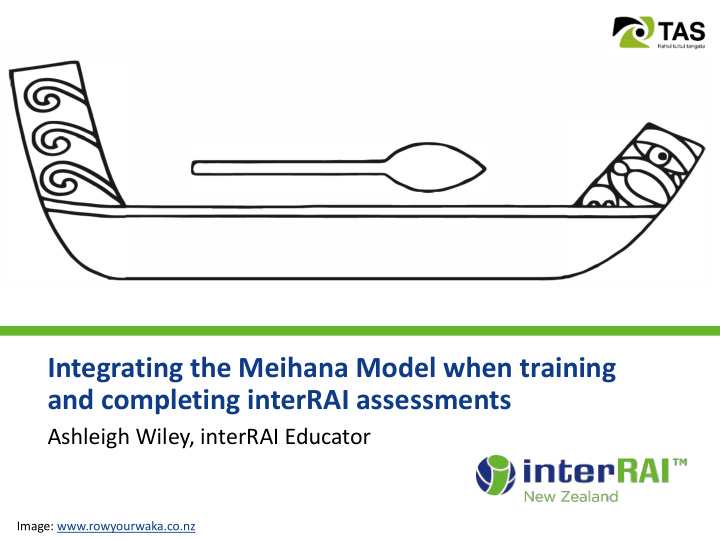



Integrating the Meihana Model when training and completing interRAI assessments Ashleigh Wiley, interRAI Educator Image: www.rowyourwaka.co.nz
• What is interRAI? • What is Meihana Model? • Importance of cultural conversation • Using the Meihana model with interRAI – components of the model 2
What is interRAI? Comprehensive clinical assessment tools International best practice Used in all 20 DHBs for home care needs assessment Aged residential care facilities Over 100,000 assessments per year 3
How does the model help us train and understand health/needs of M ā ori? Achieve Training – Hauora Cultural Access to conversation health for all Factors Components affecting the of voyage to interactions Hauora 4
Importance of cultural conversation • Address health inequalities – improve service delivery for M ā ori patients and wh ā nau • Scope of practice • Use of the Hui process to complete the Kaupapa element during clinical interaction • Culture is a determinant of health 5
Non-M āori / Māori comparison 6
The Meihana model 7
Components of the Meihana Model Patient: Patient identifying as Māori with ethnicity correctly confirmed • Often inaccurately recorded • All patients should be asked their ethnicity and have this reviewed over time • Cultural safety/competency Whānau : Support network available to the client • Often feel excluded • Inclusion important in gathering history and understanding symptoms and impact on patient/ whānau • Assess Whānau understanding of the condition, prognosis, and their expectations around management 8
Tīnana : Physical health and Functioning of the patient • Encourages to assess past and current functioning to clearly understand the physical status of the patient • Considers symptoms, treatments, exercise, diet, physical exam and substance use Hinengaro : Emotional and psychological wellbeing of the patient • Assessment needs to evaluate psychological wellbeing • Explore the patients perception of their condition and impact this has on their wellbeing 9
Wairua : Beliefs regarding connectedness and Spirituality •Explore attachments to people, places and taonga – treasured items •Allow a conversation about religion, death and dying •A lack of connectedness may be a key risk factor for depression Taiao : Physical environment of the patient/ whānau • Home environment- physical and interpersonal spaces promote privacy and dignity, for example, areas for support networks to attend • Are there potential barriers to access the service like car parking, Māori friendly environment? 10
Iwi Katoa : Health services and systems that provide patient/ whānau support • Identify whether the patient/ whānau have had appropriate access to services/systems • Exploring current enablers/barriers to access services helps towards planning care 11
Factors affecting the journey 12
Nga Roma Moana Nga hau e wha (Four winds) (Ocean Currents) Signify the societal/historical Represent components of the Māori influences on Māori world view • Colonisation • Ahua – Way other people see you • Racism • Tikanga – Maori Culture principles • Migration • Whānau – Relationships within Maori world • Marginalisation • Whenua – Genealogy and connection to land 13
Want to know more? • For further information on Te Whare Tapa Wh ā : Ministry of Health website • For further reading on the Meihana Model: Waikare o te Waka o Meihana and Meihana Model: A clinical Assessment Framework • For more information on the Meihana Model: lecture presented by Suzanne Pitama • To practice your pronunciation : Waikato University website which has audio to help you with pronunciation • To increase your Māori vocabulary you can sign up to receive a daily word from Kupu o te Ra 14
He waka eke noa We are all on the canoe, with no exception Image: www.rowyourwaka.co.nz 15
www.interrai.co.nz
Recommend
More recommend